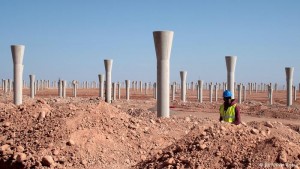Deutche Welle Germany
Morocco, host of the 2016 climate conference, intends to cover more than half of its electricity needs from renewables by 2030. In addition to massive installations, hundreds of mosques will also generate solar energy.
The sun is high and a strong wind blows over the plain. Red land extends to the silhouette of the Atlas Mountains in the distance. Here, in the rocky desert northeast of the city of Ouarzazate, Morocco has build up one of the world’s largest solar power plants.
An array of mirrors – blue as the sky – arch over the red ground. Connected in never-ending rows, the mirrors focus sunlight on a tower at its focal point, through which oil circulates, and which heats up to 400 degrees Celsius.
The heat, converted into water vapor, powers a turbine located in the middle of the mirror array. This setup generates electricity for Morocco’s high-voltage grid.
Morocco needs a lot of energy
The solar thermal power plant Noor I has been operational for half a year. Two similar factilities are under construction, and are expected to be operational by the end of next year.
Together with a planned photovoltaic facility, the mirror array of the solar power plant would provide an output of 580 megawatts (MW) by 2020 – as much as a conventional large-scale power plant based on coal or nuclear power.
Morocco needs energy. As the economy and population grow, electricity consumption has been increasing 6 percent per year. However, Morocco’s King Mohammed VI does not want to build power plants that emit greenhouse gases.
Royal energy transition
Instead, the monarch has decreed that the country adopt an energy transition program – one that is like no other among emerging and developing countries.
At the 2015 climate summit in Paris, Mohammed VI announced that the kingdom wanted to increase the share of solar, wind and water energy in the Moroccan electricity mix to 52 percent by 2030.
Currently, hydropower and wind account for 26 percent. The rest is provided by coal, oil and some natural gas – sources that emit carbon dioxide.
On the eve of the opening of the climate conference in Marrakesh, Morocco is keen to show off its new solar plant. “On the occasion of the climate conference, there are visitors coming every day who want to see the facilities,” said Tarik Bourquouquou, who is responsible for planning of the Ouazarzate solar power plants at the Moroccan Agency for Solar Power, or Masen.
Solar energy at night
The engineer observes the mirror power station from a viewing platform.”It runs steadily from morning to night, and supplies electricity even after sunset,” he said.
He points to two large steel towers that contain a special type of salt, which allow storing energy from the solar panels during the day and converting it into electricity at night. That’s when there’s the most demand, Bourquouquou said.
One of the two new projects will use a different solar technology. Several hundred rectangular mirrors will reflect sunlight to the top of a 250-meter-high tower, in which this special salt will be circulating.
Since the salt can concentrate the light energy better than the parabolic mirrors can, the salt gets even hotter, and can still produce electricity long after sunset. “For seven hours,” said Bourquouquou at the building site inspection, in front of a forest of concrete pylons on which the mirrors are to be assembled in the coming months.
The large-scale solar project, being built on an area of 3,000 hectares, is so unique that the engineer – like other colleagues – returned from France to Morocco for it. “There was no comparable project in Morocco so far,” he explained.
“This is an opportunity for my country, and I am glad to be able to participate in it.”
Programs for the rural population
The local population is also expected to benefit from the solar energy boom. Through the nongovernmental organization Agrisud International, the state energy agency Masen is funding training programs to modernize farming methods, which help increase crop production with targeted irrigation and cultivation.
One of its “clients” is Lahcen Agendouch, a 68-year-old man from the neighboring village of Tasselmant. He grows peppers, onions and parsley on his fields. “I can sell a lot more on the market today, thanks to the training,” he says, and laughs.
His wife, who looks after their goats, added that they now, have much healthier animals thanks to hygiene training done two years ago. The solar tower is easily visible from the roof of their house, beyond which are rolling. The foreground is dominated by the village mosque.
But Morocco will not limit its plans to centralized power generation in large-scale solar plants. The country has planned – together with the German Corporation for International Cooperation (GIZ) – to equip several hundred mosques throughout the country with solar technology and LED lamps. This will allow the houses of worship to cover their own electricity and heating requirements.
Criticism of wind power in Western Sahara
In all, King Mohammed VI plans to install 2,000 megawatts of solar and wind capacity each by 2030. These ambitious plans will be financed by a mix of private and public funds.
The German state-owned development bank KfW, the French Development Agency (AFD), the European Commission, and Saudi Arabian investors are financing solar projects in Ouazarzate – around 2.2 billion euros ($2.4 million) altogether.
But nongovernmental organizations Medico International and Western Sahara Resource Watch are criticizing the plans.
Morocco is planning part of its wind power capacity expansion into the Western Sahara, a disputed territory has been occupied by the Kingdom of Morocco for more than 40 years. The organizations are calling on the Moroccan government to not carry through with its expansion there.











